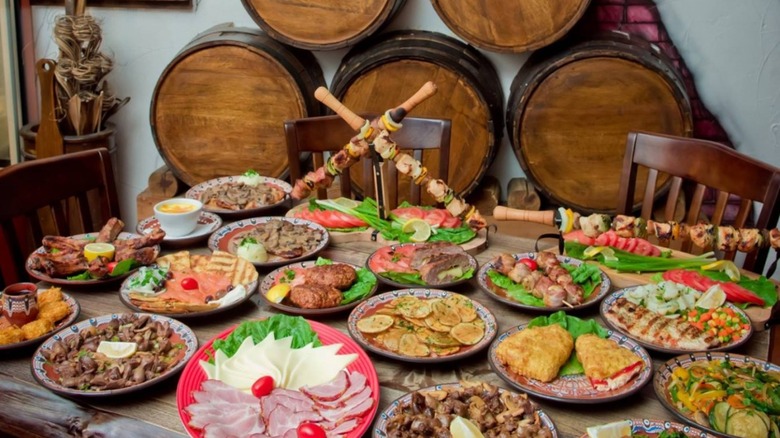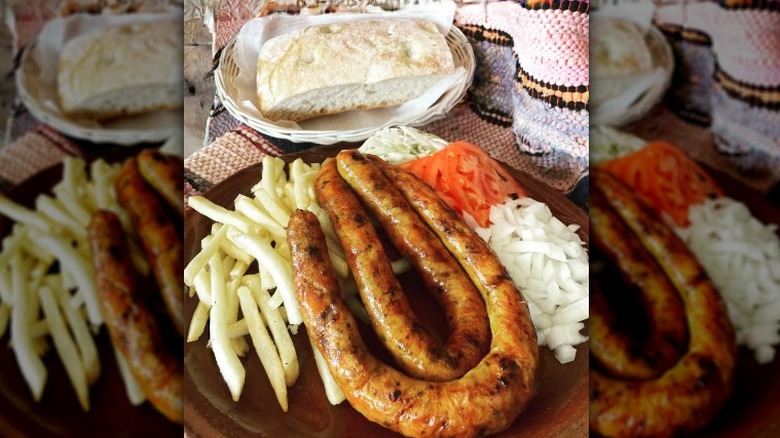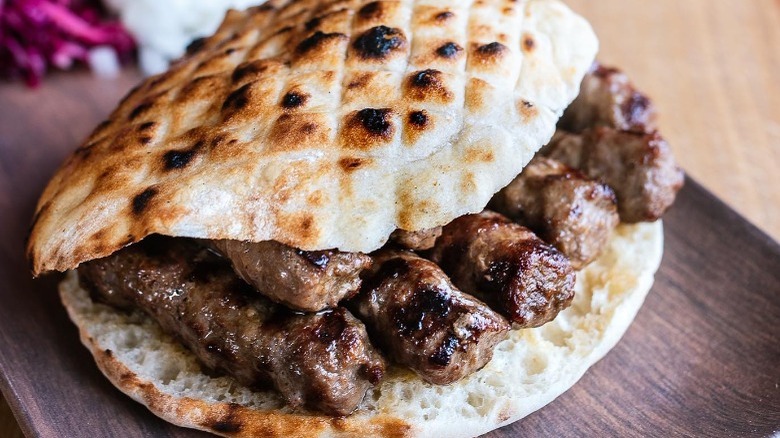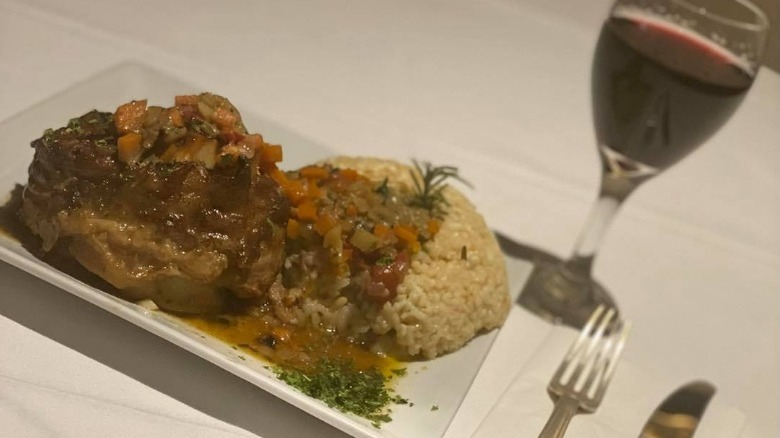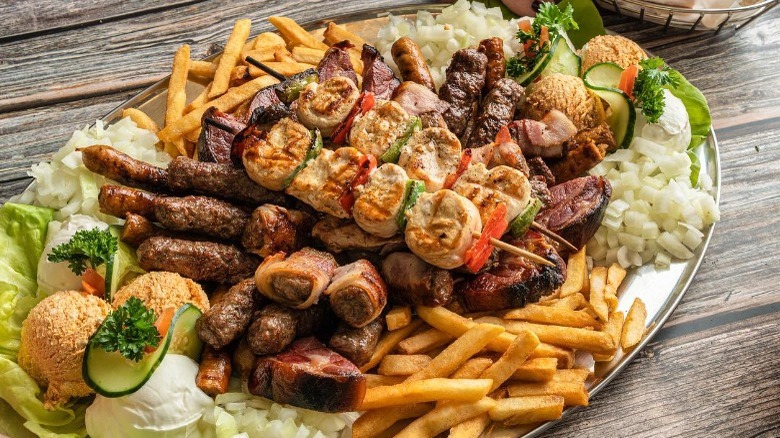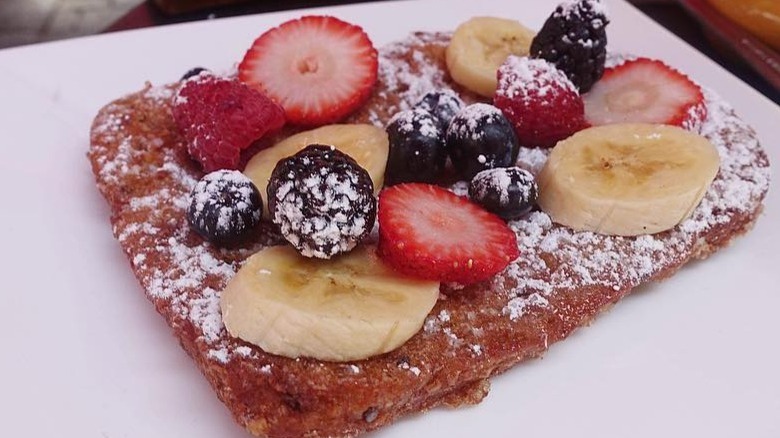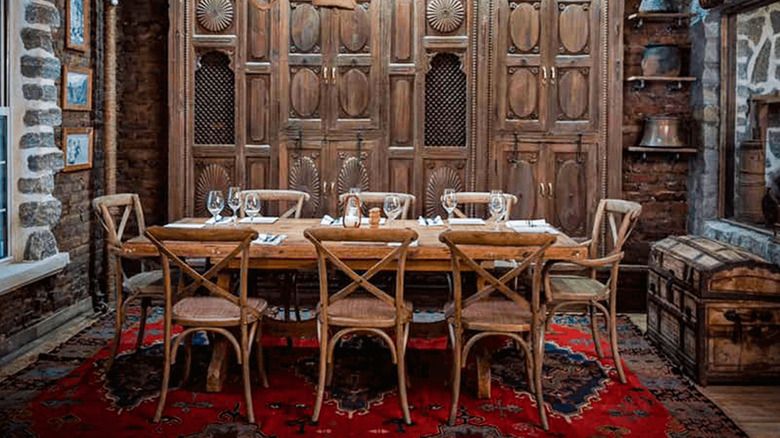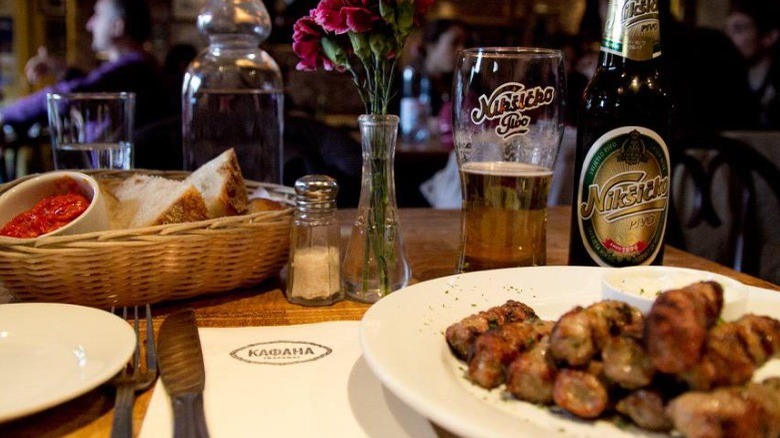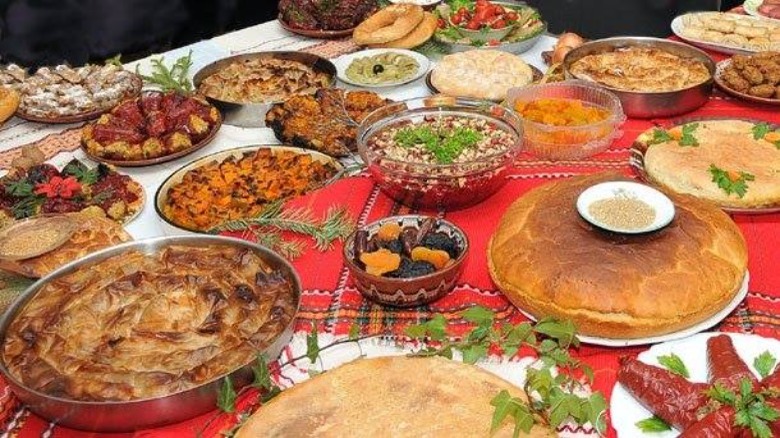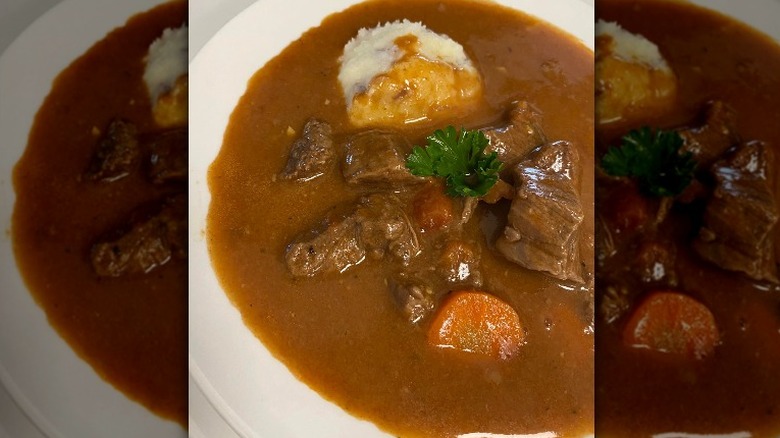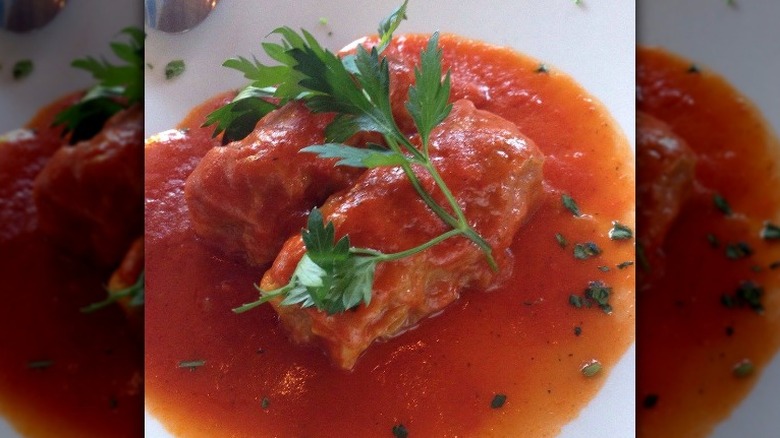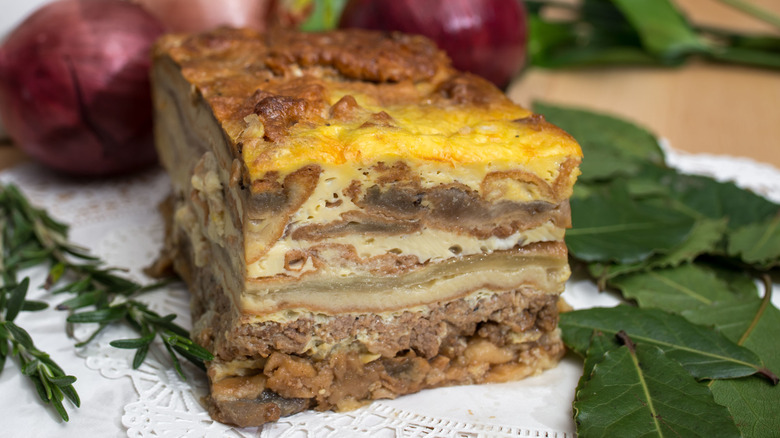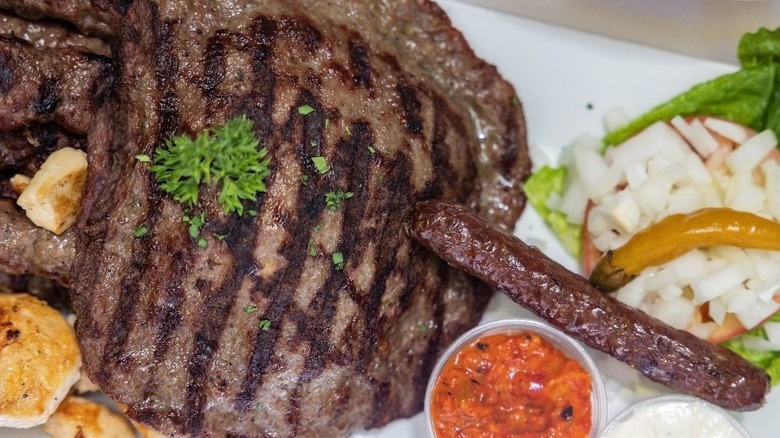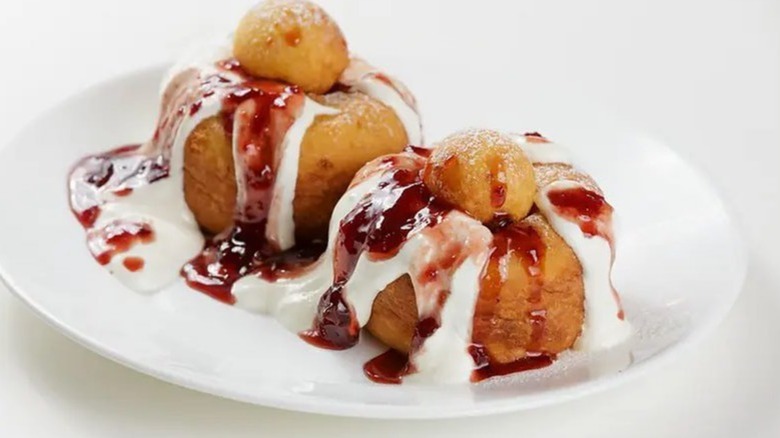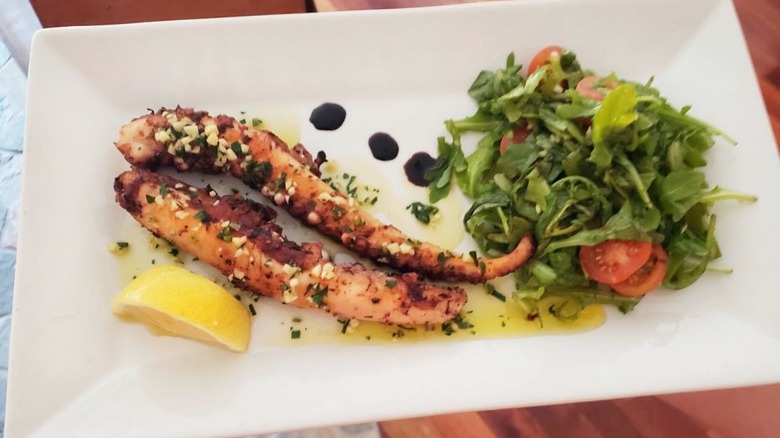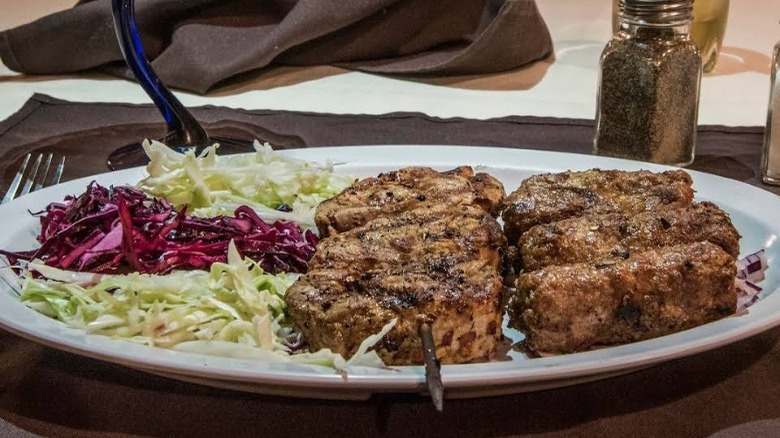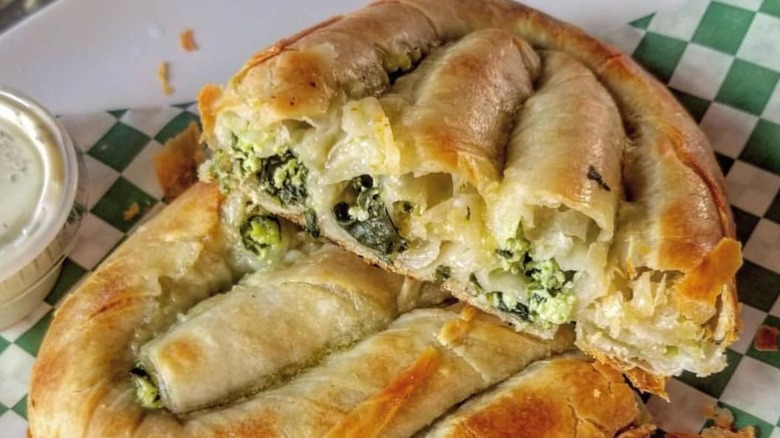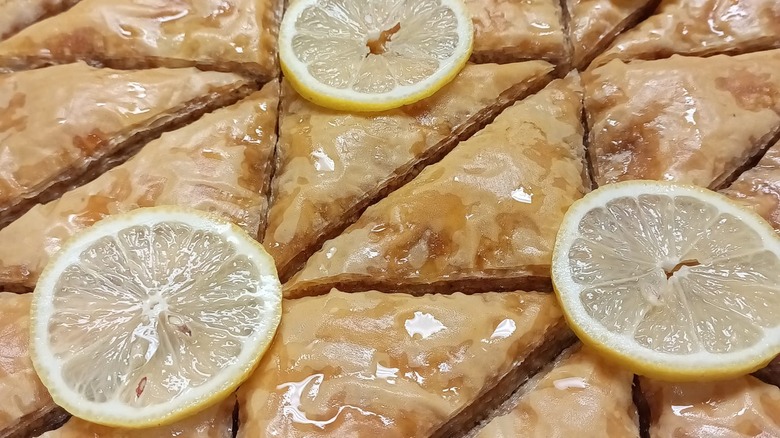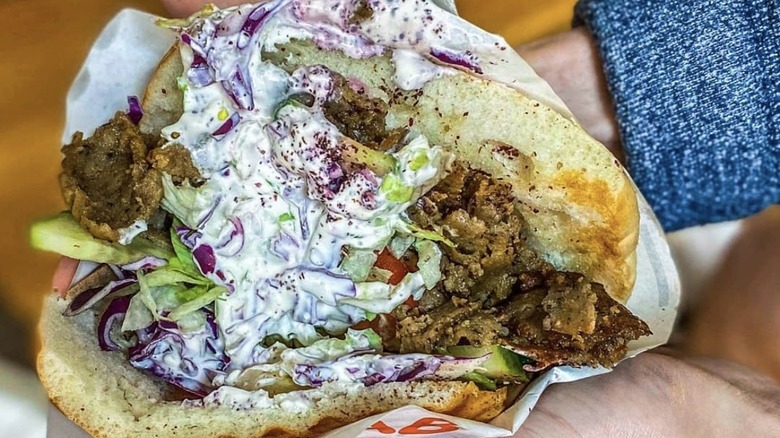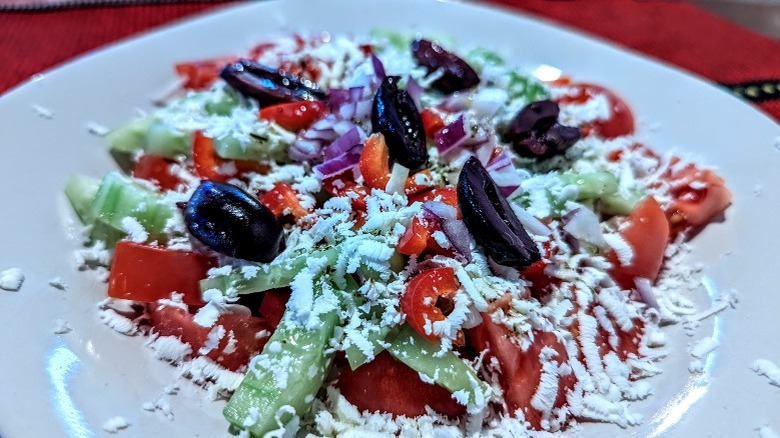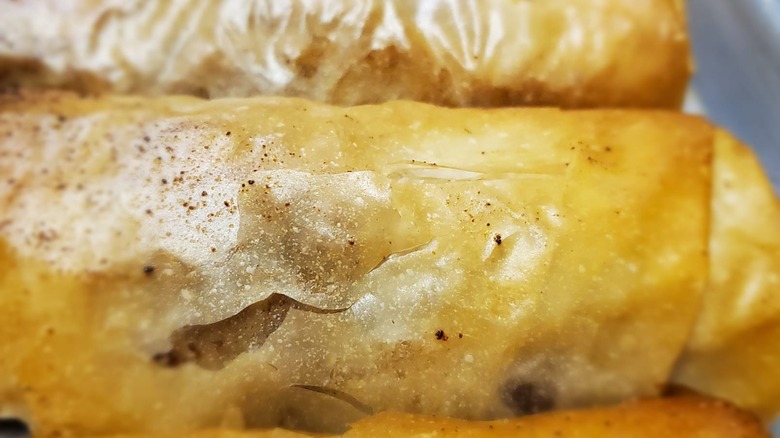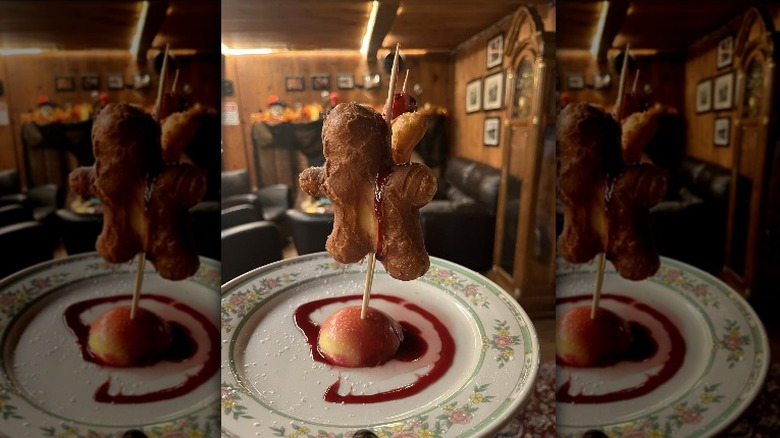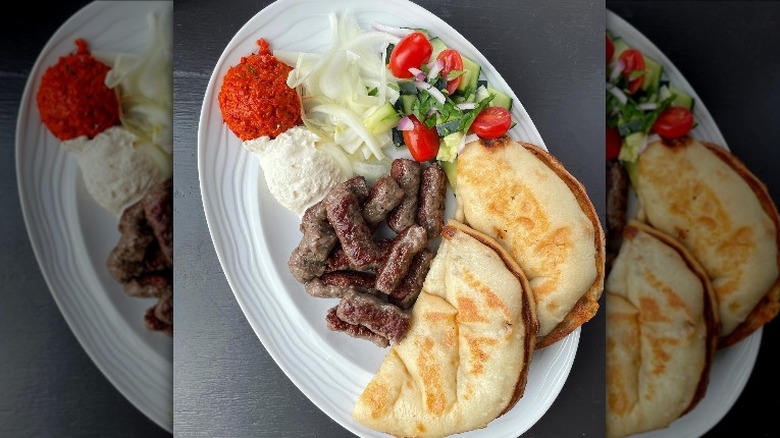22 Best Balkan Restaurants In The US
A recent car commercial shows a couple who aren't too excited about what they might eat for lunch. They're blasé about the possibility of sushi, Thai, and Indian food, but finally, settle on tacos (another familiar food option) after nearly rear-ending a food truck. If you, too, are looking to change things up, there's no need to arrange an accident. Instead, it may be time to try Balkan cuisine. While this type of food is not yet a strip mall staple, it can be found in a growing number of restaurants around the U.S. and is long overdue for some well-deserved recognition.
The Balkans as a region is generally thought to encompass the countries of Albania, Bosnia-Herzegovina, Bulgaria, Croatia, Kosovo, Montenegro, North Macedonia, Romania, Slovenia, and Serbia, per Brittanica. Not all of the Balkan nations are equally well represented on the American culinary scene, though. While there are a number of Serbian and Bosnian restaurants, there are fewer Bulgarian ones and a mere handful of the others — not a handful apiece, a handful if you clump them all together. Unfortunately, we couldn't find any Montenegran restaurants featuring kačamak, brav u mlijeku, or Njeguški steak on the menu, but pan-Balkan dishes such as ćevapi and bureks are typical for that country, as well.
Babba Grill in Darien, Illinois
Babba Grill is, as far as we are aware, one of the only U.S. restaurants specializing in Macedonian cuisine. Many of the menu offerings are similar to those of other Balkan countries: There is ćevapi and ajvar, as well as Serbian-style pljeskavica burgers and Bulgaria's famous shopska salad. There are, however, a few menu items designated specifically as Macedonian. One such item is a burger topped with cabbage salad, tomatoes, cucumbers, fries, mayonnaise, and ketchup. Another is a Macedonian-style pork sausage made with leeks, dried peppers, and paprika that is stuffed into lamb casings.
Babba Grill even offers Macedonia's selsko mesa, which translates as country meat. The restaurant makes its version of the dish from chicken or pork chunks, meatballs, mushrooms, and cheese cooked in Espagnole sauce (one of the five "mother sauces"). While it sounds absolutely amazing, unfortunately, selsko mesa is only available for catering orders for parties of six or more.
Balkan Treat Box in Webster Groves, Missouri
Balkan Treat Box has received quite a bit of media attention for a Midwestern restaurant specializing in a lesser-known European cuisine as its website touts accolades from Food & Wine, Bon Appetit, Esquire, and Food Network, and one of its chefs was a James Beard semifinalist. While the restaurant offers a limited menu for dine-in or takeout (and even mail order by way of Goldbelly), what it does, it does very well.
Among the Balkan treats on offer are ćevapi, pljeskavica, and sopska (aka shopska) salad. It also has a few Turkish treats which are actually not too out of place here. According to Britannica, the very word Balkans is Turkish (it means mountain), and parts of Turkey lie on the Balkan peninsula. The Turkish menu items at Balkan Treat Box include doner kebabs, wrap sandwiches known as lahmacun, and the flatbread pizza called pide. For dessert, there's sutlija, a very pretty rice pudding decorated with rose petals and pistachios, and the beverage list includes Balkan beer and the Turkish yogurt drink called ayran.
BG Bistro in Las Vegas
When you think of restaurants in Las Vegas, what comes to mind? Probably casino buffets, or maybe some celebrity chef's place. A Bulgarian bistro, though? That's a bit more unexpected, but BG Bistro has been a Sin City fixture since 1993.
BG Bistro's menu includes several traditional Bulgarian meat dishes. One of these is uviatch, described as bacon-wrapped ground pork stuffed with pickles, mushrooms, and cheese. Another is veshalitza, which consists of ground pork with a filling of ham, pickles, mushrooms, and cheese. There are also Bulgarian-style meatballs called kufteta as well as a spicy spiral sausage known as karnache. Not all of the Bulgarian dishes are quite so meaty, however. These also include a vegetable-based dip called lutenica; panagyurski eggs, which are poached and served with garlicky yogurt and paprika butter; and a cold soup called tarator made of cucumbers, yogurt, walnuts, and dill.
Cafe Beograd in Chicago
While Cafe Beograd specializes in Serbian food, Beograd (aka Belgrade) being that country's capital, the website also says it does "regional Balkan" cuisine. It is one of the more well-established restaurants on the list, having been in business since 1984, so at almost 40 years old, it's practically ancient in restaurant years.
If you're a fan of charcuterie boards, be sure to order the meze at Cafe Beograd. This includes a selection of smoked meats and cheeses, and the BG meze also includes ajvar as well as the spicy cheese salad called urnebes. The menu is pretty meat-heavy (Serbians do love their meat), with cevapchichi (ćevapi), pljeskavica, a cheese-and-bacon-stuffed karadjordje's schnitzel, and raznjici, which are chicken or pork skewers. There is also a wide range of crepes with both savory and sweet fillings, as well as other dessert offerings such as the chocolate and vanilla cake known as ledena kocka and the Balkan-style cream puffs called princess krofna.
Cafe Bubamara in Clifton, New Jersey
Cafe Bubamara, as its website makes clear, is an establishment run by those who are nostalgic for the days when Yugoslavia was still a country. Its cuisine, therefore, isn't meant to be specifically Serbian, Croatian, Bosnian, or anything else, just pan (former)-Yugoslavian. Its décor, as well, is full of vintage charm.
The menu, true to the restaurant's name, is mainly oriented to café-style offerings such as coffee drinks (including Turkish coffee), palačinke (crepes), Balkan-style waffles called bakin kolač, and the French toast known as prženice. The latter comes with a range of sweet or savory toppings such as jam, fruit, feta cheese with prosciutto, and even smashed avocados. An extensive selection of pastries is also available, including the fruit, cream, and walnut-filled voćna torta and the hazelnut/vanilla cream lješnik torta. However, if you want a more substantial meal, you can choose from traditional dishes including ćevapi, Balkan-style burgers, or bureks filled with meat, cheese, spinach, potatoes, mushrooms, or apples.
Çka Ka Qëllu in New York City
If you visit Çka Ka Qëllu, though, you'll be treated to some of the best (and possibly only-est) Albanian and Kosovar cuisines you're likely to find anywhere outside of, well, Albania or Kosovo, with the possible exception of Gjyshja's house if you happen to have roots in either of these countries.
So what does Albanian/Kosovar cuisine look like? Some of the dishes on Çka Ka Qëllu's menu are similar to ones you'll see throughout the Balkans, albeit with a different spelling: ajavar (ajvar) shop (shopska) salad, and sausages called qebapa that seem pretty similar to ćevapi. The restaurant does offer a number of Albanian specialties, such as lecenik, a cornbread made with cottage cheese and spinach that The New York Times praises for its almost cheesecake-like texture. There are also several veal-based dishes, including the baked veal dumplings called mantia në tavë, the sausage known as suxhuk, and qofte, which are meatballs flavored with onions, herbs, and crushed red pepper. The dessert menu has a few Albanian specialties, as well, including the sweet pastry known as sheqerpare and trilece.
Kafana in New York City
Kafana, a Serbian restaurant that opened in the East Village in 2008, is one that has a certain nostalgic vibe to it. The New York Times describes its feeling as that of a village tavern in prewar Yugoslavia and on weekends the ambiance is even enhanced by live Balkan folk music.
While many of Kafana's customers tend to be hardcore carnivores drawn there by traditional meat dishes such as ćevapi, pljeskavica, raznjici, karadjordjeva, the lamb stew called jagnjeca kapama, and the braised pork shoulder dish svinjska plecka, that's not the only reason to pay it a visit. The feta cheese pies known as gibanica and zeljanica (the latter made with spinach), the baked bean dish called prebranac, and the warm lepinja bread with kajmak cheese spread are equally tasty. If you want to experience a little bit of everything Kafana has to offer, a prixe-fixe menu includes a choice of appetizers, salads, main dishes, and desserts for $55.
Mehanata in Des Plaines, Illinois
Mehanata offers Bulgarian cuisine served in a setting heavy on old-world ambiance. The romantic atmosphere would actually be perfect for an anniversary or Valentine's dinner. You could also make it a breakfast date, as the restaurant serves three meals a day — the two of you could start off your day with yogurt-poached eggs panagurski or Bulgarian donuts that come with both feta cheese and jam.
One of Mehanata's lunch and dinner specialties is shashlik, which is skewer-grilled beef, pork, chicken, and/or sausage. The restaurant also offers a variety of traditional clay pot dishes known as sach, with available combos including kasapski sach made with bacon, chicken, pork, sausage, mushrooms, onions, peppers, and pickles; mehanata sach, which is pork or chicken cooked with bacon, mushrooms, onions, pickles, and french fries; and rodokski sach, which includes pork or chicken, carrots, corn, mushrooms, onions, and pickles. There's even a vegetarian sach made from carrots, corn, dill, mushrooms, onions, pickles, and zucchini. Do try to save room for dessert, though. The house specialty is a cake made from figs and mascarpone, while there are various other Bulgarian cakes to choose from.
Mersim's in Waterloo, Iowa
While Mersim's specializes in Bosnian cuisine, that's not the only thing it's got cooking. It's in Iowa, not N.Y.C., after all, so the menu does offer a range of standard American items such as burgers, steaks, and chicken parmesan. If you keep scrolling through the menu, though, you'll find that not only do a few Bosnian items such as the Balkan salad and ćevapi appetizer pop up in the "American" section but there are actually two whole pages of Bosnian specialties at the bottom.
Among the Bosnian dishes that we haven't covered already are a thin-sliced version of chicken-fried steak called becka snicla and grah, which is a bean stew made with smoked beef. There's also telece pecenje, which is roast veal; begova corba, a beef and cabbage stew; and cufte u paradajz sosu, which consists of meatballs in a tomato cream sauce served atop egg noodles or mashed potatoes. For heartier appetites, however, Mersim's offers a multicultural mješano meso (mixed grill) that includes not only ćevapi, kebabs, and the aforementioned becka snicla, but also features steak, fried chicken wings and tenders, cheddar and broccoli-stuffed chicken, french fries, and onion rings.
Miro's in Palm Springs, California
Miro Terzic is a restauranteur and culinary star from Mostar in Bosnia and Herzegovina. He opened his namesake Palm Springs eatery, Miro's, in 1994 with the intent to offer a menu influenced not only by his Balkan background, but by culinary traditions from Hungary, Germany, and the overall Mediterranean, as well.
Although Miro's offerings currently range from Moroccan lamb meatballs to osso bucco to Spanish octopus and even Budapest-style schnitzel, there are a few typical Balkan dishes on the menu. One of these is burek, which here comes stuffed with ground beef, potatoes, and onions, and the other is cabbage rolls. Stuffed cabbage rolls are pretty popular across eastern Europe, with variants including Ukrainian holubtsi and Polish golumpki, but Miro's version is described as being a "family recipe from the old country," which means it's likely to be a Bosnian-style dish you'll not find elsewhere.
Old Town Serbian Gourmet in Milwaukee
Old Town Serbian Gourmet has been around for over half a century, having opened its doors in 1971, but is still family owned after all these years. The restaurant's cuisine couldn't be any more traditional as some of the recipes are hundreds of years old. Owner Natalia Radicevich tells Milwaukee's Shepherd Express the family plans on never updating the menu because they like how things are going and it's working for them. The restaurant's décor, too, is very Old World — dining here feels as if you've stepped straight into the Milwaukee Public Museum's European Village exhibit.
On the menu at Old Town Serbian Gourmet are all of the Serbian favorites: raznjici, chevapcici, sarma (meat-stuffed cabbage rolls), and burek, although a note on the menu offers the caveat that this last-named dish will take some time to prepare. The restaurant also does a Serbian-style musaka, which is different from the Greek version of this eggplant/beef casserole in that it's topped with a baked egg custard. On special occasions like Thanksgiving or Christmas, the restaurant has even been known to offer roast goose, which is something you don't see on too many menus.
Rakija Lounge in Miami
Rakija Lounge is a Serbian-ish restaurant and bar in that much of what's on offer is standard American fare such as pizza, wings, fajitas, and surf and turf, but there are a number of Serbian specialties, as well. Serbian items pop up here and there on the menu — the doughnuts known as ustipci are a breakfast option, shopska is one of the salad choices, and burek is listed as both an appetizer and a sandwich. There is also a selection of "Mediterranean" entrees that include ćevapi, karadjordjeva schnitzel, pljeskavica, sarma, and sudzukice, this last-named being a type of beef and veal sausages.
The real specialty at Rakija Lounge, however, is the eponymous Serbian fruit brandy that the restaurant describes as being both "strong and dainty." The rakija it serves is made in-house and comes in a variety of styles. The ones on offer at present include dunjevaca (quince), kajsijevaca (apricot), loza (aged grape), viljamovka (pear), and sljivovica (plum), the last of which is considered to be Serbia's national drink.
Romanian Garden in New York City
There's no guessing about the type of cuisine served up at Romanian Garden, as the name says it all. Romanian meals are typically Balkan in that these tend to be pretty meat-oriented, and Romanian Garden's menu is no exception. City Seeker describes dining there as "an adventure in hearty, somewhat artery-clogging food." No worries if you're unfamiliar with the food or the language of Romania, however, as the menu helpfully lists each dish under an English as well as a Romanian name.
Among the more intriguing menu options are items such as grilled pork neck (ceafa de porc), breaded veal brain (creier pane), and tripe soup (ciorba de burta). If you're no fan of offal, though, there are plenty of other dishes from which to choose. These include roasted lamb leg (rasol de miel la cuptor), Romanian stew with polenta (tochitura Moldovenesca cu mamaliguta), and polenta with feta and sour cream (mamaliga cu branza si smantana), while the dessert menu features crepes with Nutella or jam (clatite cu Nutella sau gem) and cheese fritters with jam and sour cream (papanasi).
Selo in New York City
The Croats and Serbs may have fought a bloody, not-so-civil war back in the '90s as the former Yugoslavia was tearing itself apart, but nearly three decades later, one restaurant in Queens is trying to re-unite the two south Slavic nations under the umbrella of a single menu. Selo's proprietors, Croatian Elvis and his Serbian wife Suzana, aren't exactly the Balkan version of Romeo and Juliet as they actually met in the U.S. long after the war was over, but to this day, their restaurant is the only one in the U.S. to specialize in both Serbian and Croatian cuisine.
As the restaurateurs told The Plitvice Times, Selo is meant to showcase both the more Mediterranean-influenced, seafood-based Croatian cuisine as well as the meatier Serbian style of cooking, as the former would be unfamiliar to immigrants from the latter country and vice-versa, while both types of food would likely be new to non-Balkan customers. The most popular menu items at Selo are the Serbian karadordjeva and the Croatian Istrian gnocchi with shrimp, while other entrees include calamari stuffed with potatoes and Swiss chard, grilled octopus, bow-tie pasta in a veal ragu sauce. ćevapi, and a cheese-and-bacon-filled ground meat dish called gurmanska.
Serbian Village Restaurant in Chicago
Serbian Village Restaurant is a small neighborhood kind of place, but it offers one thing that most other Balkan restaurants do not: live jazz music. The restaurant's website mentions that it hosts a Monday night open jam session, as well as jazz performances on both Friday and Saturday nights.
The menu at Serbian Village hits all of the typical Serbian highlights as it offers ćevapcici, raznjici, pljeskavica, and karadjordjeva along with muc'kalica, which is a dish of sautéed pork with peppers, onions, and tomatoes. The restaurant even offers a few options for those who don't eat red meat, these being fried catfish, as well as a veggie plate with roast potatoes, cabbage salad, and Serbian salad. (This dish is not for vegans, however, as the Serbian salad includes cheese.) Desserts include palacinke, which are Serbian-style crepes, as well as strudi od jabuke ili visnje, which translates to strudel with apple or sour cherry filling.
Sofra Urbana Grill in Fountain Valley, California
Sofra Urbana, a restaurant featuring the foods of Bosnia-Hercegovina, takes its name from a traditional Bosnian serving platter. The sofra, the restaurateurs say, is meant to symbolize family-style dining and the restaurant's stated hope is that customers will feel as if they are guests in a Bosnian home. As Bosnia is a country with a large Muslim population, all of the meat served by the restaurant (and there is a lot of it, since Bosnians are just as fond of the stuff as are their neighbors, the Serbs) is halal-certified.
Sofra Urbana's menu offers such pan-Balkan dishes as ćevapi, pljeskavica, shopska salad, and burek. The Sofra burger is a bit more Bosnia-specific, though, as it consists of a patty stuffed with Bosnian dried meat and cheese. Bosnian charcuterie also features on the pizzas, particularly the Balkan Special topped with suho meso (smoked beef), soyuk (salami), and kaymak cheese.
Tata's Grill in East Ridge, Tennessee
Tata's Grill is a Bosnian restaurant located in, of all places, East Ridge, Tennessee. The town seems to be pretty proud of this not-so-common type of restaurant, as the mayor has posted photos of a recent visit to his Facebook page. In contrast to the Old World décor adopted by many Balkan restaurants, Tata's has opted for a modern, casual dining look. The menu, too, shows an attempt to streamline the ordering process, as all of the dishes come with a description and in some cases even include pronunciation tips (ćevapi = "tche-va-pee") or nicknames (P-Burger for pljeskavica).
In addition to the above items, Tata's Grill also offers sarma and goulash (gulas) along with some more Mediterranean/Middle Eastern style items like doner and gyros. The restaurant also has a couple of hybrid dishes such as an American-style cheeseburger topped with Bosnian pickles, Philly sandwiches (beef or chicken) served on lepinja bread, and chicken tenders with a kajmak dip. The menu even offers Bosnian coffee and Balkan sodas (Cockta and Jupi), juices, mineral water (Radenska), and beer in addition to the standard American lineup of Coke, Pepsi, iced tea, and macro brews.
The Balkan House in Ferndale and Hamtramck, Michigan
The Balkan House is, if not exactly a full-fledged chain, that rare Balkan restaurant that has successfully spun itself off into two separate locations. While Balkan is in the restaurant's name, it promotes itself as offering "a taste of Europe." Apparently, this taste is one that extends well beyond the Balkan peninsula, and in some cases outside of Europe itself.
On the menu at Balkan House are all of the usual suspects: pleskavica, shopska salad, and chevapi, this last available as part of a breakfast wrap or platter as well as on the main menu. The restaurant also makes Bosnian bean soup known as grah. Other menu items include Middle Eastern favorites like falafel, Turkish coffee, and a fava bean breakfast dish called foul which is similar to the Egyptian dish called ful medames. The house specialty, however, seems to be döner kebabs, which are Turkish in origin but a favorite street food in Germany. The Balkan House acknowledges that its kebabs (also available in a basket, bowl, salad, or wrap form) are Berlin-style and even spells the word with the Germanic umlaut.
The Border Stop in Post Falls, Idaho
If you're ever in the bustling metropolis of Post Falls, Idaho, located right by the border with Washington state, you may decide to stop for a bite at a likely-looking restaurant called The Border Stop. Should you do so, you might have been in for a bit of a surprise had you not read this article. At first glance, the menu seems to offer pretty typical brunch/light lunch fare with its croissant sandwiches, salads, shareables, and crepes.
The Border Stop does have an awful lot of crepes, though – over 20 varieties of sweet, savory, and breakfast ones. Once you look past the cutesy names like "Sugar Sugar," "Almost Elvis," "Cheesy Pig," and "Mr. Roni," though, you may start to notice some unexpected items such as a Balkan crepe with Bulgarian feta and the tomato/pepper spread known as lutenitsa. Moving past the crepe section, you'll also find shopska salad, sarma, and several different varieties of a Bulgarian dish known as princessa. What's going on here? A Bulgarian restaurant owner, that's what (or who). Dimitar Gerov, according to The Spokesman Review, immigrated to the U.S. in 2014 and he and his Alaska-born wife Heather opened their Bulgarian-American bistro in March of 2022. While the Bulgarian dishes The Border Stop offers are limited in number at present, the Gerovs have plans to introduce more of these once all of the necessary ingredients can be sourced.
Three Brothers Restaurant in Milwaukee
Three Brothers Restaurant is one of two Milwaukee-based Serbian restaurants with a long pedigree. It dates back to 1956, but one of the brothers for which it was named eventually split off from the family business to found Old Town Serbian Gourmet 15 years later. Both restaurants today are still run by Radicevics, although the Old Town ones now spell their name with an "h" at the end, while the Three Brothers ones do not.
Three Brothers, of course, offers typical Serbian dishes like chevapchichi, pleskjavica, raznjici, sarma, and burek on the menu, this last-named being stuffed with a choice of beef, cheese, or cheese and spinach. The menu also features roast goose, duck, and lamb, while desserts include palacinka, strudel, and a seven-layer fruit and walnut-filled torte. While the menu is typically Balkan in its heavy use of meat and dairy, Three Brothers says it can prepare vegetarian or even vegan versions of certain dishes if given 36 hours notice.
Transilvania Restaurant & Bar in East Haven, Connecticut
While the Transilvania Restaurant & Bar is named after a region in central Romania, the proprietors are well aware of what the name means to most English language speakers and definitely play up on the whole "Dracula" association. The décor, while traditionally Romanian, is embellished with various vampire-themed items, the servers are dressed in black and red, and, as the Hartford Courant points out, the restaurant's seven-digit phone number spells out "BITE YOU." Also, if you need to use the facilities, you could find yourself in the "Bat Room." (Who said vampires have no sense of humor?)
The menu plays it straight, for the most part, with classic Romanian dishes such as smoked pork and bean soup, pork and rice-stuffed cabbage rolls, and an egg-topped stew made from sausages, bacon, pork, chicken, and polenta. Here and there, however, you'll find something that combines tradition with a little kitschy fun such as a Vlad the Impaler dessert consisting of traditional Romanian doughnuts served with berry jam and strawberry syrup "blood."
Zivio in Grand Rapids, Michigan
Zivio offers what it calls "modern European cuisine," but the website goes on to clarify that what is meant by this is basically Bosnian with some Greek, Turkish, and Central European influences as is typical of the region. A look at the menu, though, shows quite a few dishes that seem to fit the New American profile, as well, such as za'atar-seasoned Brussels sprouts with a honey/harissa glaze and a trio of tacos made with naan bread.
We're here for the Balkan food, though, so we'll take a closer look at the menu to find those items. Ćevapi puts in an appearance, along with ajvar and kajmak, while lepinja bread not only accompanies the ćevapi but is used for several different sandwiches and dips. Zivio even uses this traditional bread to make a not-so-traditional dessert called lepinja puffs where pieces of the stuff are deep-fried, sprinkled with cinnamon sugar, and drizzled with Nutella. The drinks menu, too, has several Balkan beverages including Bosnian beers; wines from Bosnia, Croatia, North Macedonia, and Romania; cocktails made with rakija and the Croatian pear liqueur kruskovac; and Slovenian mineral water called Radenska.
